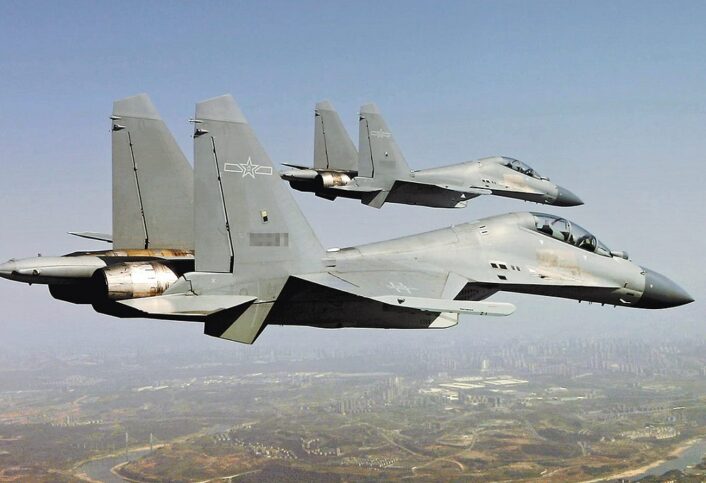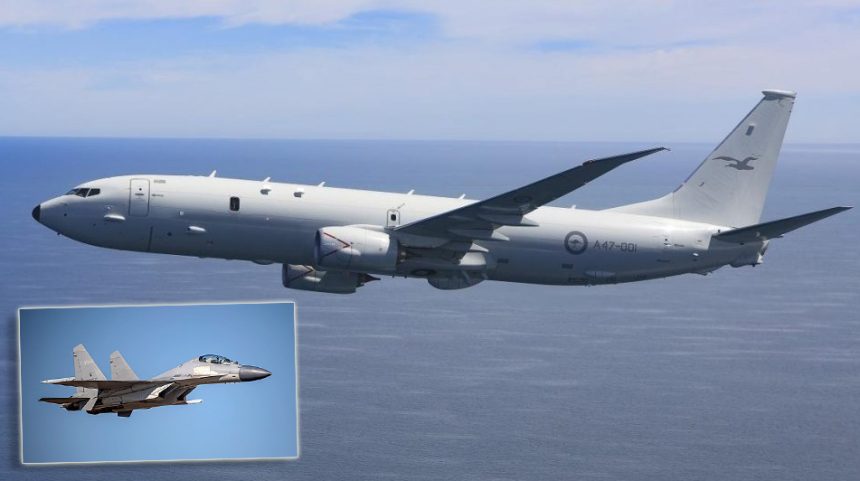The Chinese fighter jet cut across the Poseidon’s trajectory while releasing chaffs, some of which where ingested by the engines. The event occurred in international airspace.
The Australian Ministry of Defence just disclosed that a Royal Australian Air Force P-8A Poseidon Maritime Patrol Aircraft was involved in an unsafe intercept by a People’s Liberation Army Air Force J-16 fighter jet on May 26, 2022. The Poseidon was performing a routine maritime surveillance activity in international airspace over the South China Sea when the incident happened.
Defence Minister Richard Marles said the fighter jet first flew close to the side of the Poseidon and released chaffs. “The J-16 then accelerated and cut across the nose of the P-8, settling in front of the P-8 at very close distance,” he added. While performing this maneuver, the J-16 released “a bundle of chaff”, some of which were ingested by the engines of the Poseidon. The P-8 was able to return to base safely after the incident.
“The intercept resulted in a dangerous manoeuvre which posed a safety threat to the P-8 aircraft and its crew. The Australian Government has raised its concerns about the incident with the Chinese Government,” said the press statement. “We were operating completely within our rights and international law. Quite obviously this is very dangerous.”
FlightGlobal was able to provide some more details, mentioning that that flight tracking data suggests the incident occurred far to the south of China and just west of the Philippines. According to their info, the Australian P-8 involved bears the registration A47-008 and was operating from Clark Air Base in the Philippines, while it is possible the Chinese J-16 was operating from one of the air bases China has built on atolls in the South China Sea.
“The activity of the P-8 form part of maritime surveillance activity which has been undertaken by Australia in the South China Sea for decades – other countries do the same”, said the Defence Minister. “I want to make it also very clear that this incident will not deter Australia from continuing to engage in these activities, which are within our rights and international law, to ensure that there is freedom of navigation in the South China Sea because that is fundamentally in our nation’s interest.”

Whatever, the use of chaff and flares is not usual in this kind of close encounters we observe quite frequently all around the world. As pointed out by RC-135 aircraft commander and national security historian Robert Hopkins, the use of these countermeasures can cause a physical damage to the intercepted aircraft.
Chaff or flares. Either way they cause physical damage ranging from cosmetic to fatal.
This is not some “cowboy” misjudging a close pass but an intentional physical attack on an airplane in international airspace. https://t.co/SxvDn2veB3
— Robert Hopkins (@CobraBall3) June 5, 2022
This incident comes few months after another incident, during with a People Liberation Army Navy warship illuminated with a laser a RAAF P-8. The ship, a Luyang-class guided missile destroyer, was sailing east through Australia’s Exclusive Economic Zone, in the Arafura Sea, between the Northern Territory and Papua, in company with another PLA-N ship, a Yuzhao-class amphibious transport dock.
It’s noteworthy also the timing with another incident. In fact, a Canadian CP-140 Aurora Maritime Patrol Aircraft was intercepted, also on May 26, while flying a United Nations-sanctioned mission against North Korea in international airspace. The Canadian aircraft was intercepted multiple times in the month before this incident, with pilots having to quickly maneuver to increase separation and avoid a potential collision with the intercepting aircraft.
The Canadian website Global News reported some more details: “Those jets are frequently flying as close as 20 to 100 feet from the Canadian plane, sources say — so close that Canadian pilots can make eye contact with the Chinese pilots, and sometimes see them raising their middle fingers.”
The Canadian CP-140 Aurora has recently taken part in Operation Neon, part of UN efforts to monitor sanctions against North Korea and prevent the rogue nation’s development of weapons of mass destruction. The plane was flown frequently by multiple rotating crews deployed at Kadena Air Base, Japan, from April 26 to May 26, 2022.
Interestingly, while the Canadian Government acknowledged the incident a few days later, the Australian Government only acknowledged the details about the incident with public statements as the info arrived to journalists through other sources and then asked for confirmation.
On Saturday the Australian DOD issued a written public statement acknowledging a dangerous intercept and then today (ET time) acknowledgment there were flares deployed.
— Mercedes Stephenson (@MercedesGlobal) June 5, 2022
The two incidents happened as China is continuing to increase its presence in the Asia-Pacific region and particularly in the South China Sea near Taiwan. A few days after these incidents, China made the second largest incursion into Taiwan’s air defence identification zone (ADIZ) this year, with reportedly 30 jets entering the area. Since the beginning of the year, Taiwan has reported 465 incursions, with about a 50% increase compared to the same period last year.









